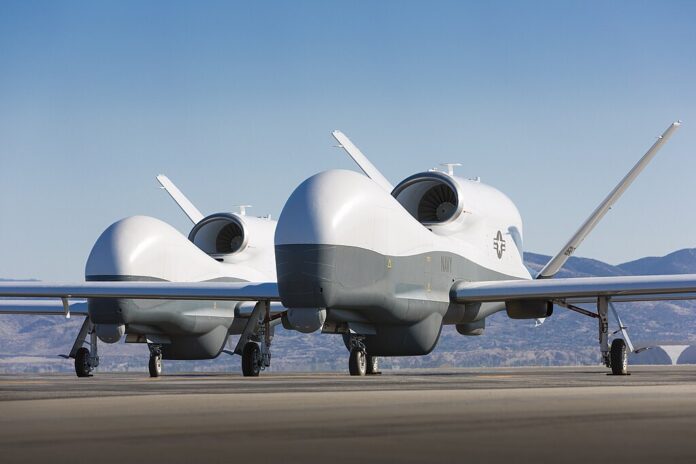The arrival of the MQ-4C Triton in the northern territory marks a significant boost in Australia’s maritime surveillance capabilities
Australia is set to receive the first of at least four advanced unmanned surveillance aircraft from the United States this weekend. The MQ-4C Triton, a large drone designed for long-range maritime monitoring, is expected to play a crucial role in tracking unauthorized maritime arrivals in the country’s northern waters.
The Triton, known as “AUS 1,” departed from a Californian Naval Air Station and is en route to Royal Australian Air Force (RAAF) Base Tindal in the Northern Territory. Following months of rigorous test flights, the drone is set to arrive late Saturday night. Eventually, these drones will be remotely piloted by the RAAF from the Edinburgh Air Base near Adelaide, enhancing the Australian Border Force’s maritime patrol and military surveillance operations.
Embed from Getty ImagesDespite its impressive capabilities, the Triton has faced criticism. Sceptics argue that its high-altitude operation makes it vulnerable to enemy attacks and ineffective in monitoring small wooden boats used by people smugglers. However, proponents counter that the Triton’s ability to cover tens of thousands of square kilometres in a single 28-hour mission and provide real-time visual and electronic data makes it a valuable asset.
Australia’s acquisition of the Triton comes as the country deals with several recent unauthorized boat arrivals that have evaded detection. The arrival of the Triton is part of a $1.5 billion enhancement to the RAAF’s capabilities, confirmed last year by Defence Industry Minister Pat Conroy. This acquisition continues despite the US Navy halting production of the costly platform.
Air Vice-Marshal Wendy Blyth, head of Air Force Capability, highlighted that RAAF pilots and crews have been training extensively in the United States to ensure effective deployment of the MQ-4C Triton. These personnel received the same training as their US Navy counterparts, gaining valuable experience to maximize the drone’s operational potential.
The MQ-4C Triton is based on the RQ-4B Global Hawk, used by the US Air Force, Japan, and NATO, but optimized for maritime reconnaissance. Australia’s interest in acquiring the Triton dates back over 20 years, reflecting a long-term strategic commitment to enhancing its surveillance capabilities.
Analysis:
Political:
The arrival of the MQ-4C Triton represents a significant political milestone for Australia, bolstering the country’s defence and surveillance capabilities amid growing concerns about unauthorized maritime arrivals. This development aligns with Australia’s broader strategic initiatives to enhance national security and maintain robust border control. The acquisition underscores the government’s commitment to leveraging advanced technology for national defence, potentially strengthening its political standing both domestically and internationally.
Social:
Socially, the deployment of Triton drones could alleviate public concerns about border security and unauthorized maritime arrivals. Enhanced surveillance may lead to better detection and management of such incidents, thereby increasing public confidence in the government’s ability to protect the nation’s borders. However, there could also be ethical and privacy concerns regarding the use of unmanned drones for surveillance, necessitating transparent communication from the government to address any public apprehensions.
Economical:
Economically, the Triton drones represent a substantial investment in Australia’s defence infrastructure. The $1.5 billion expenditure is expected to yield significant returns in terms of enhanced maritime security and protection of national interests. Improved surveillance can deter illegal activities, potentially reducing costs associated with border breaches and illegal immigration. Additionally, the use of advanced technology could spur further investments in the defence sector, fostering economic growth and technological innovation.
Technological:
The MQ-4C Triton drones embody cutting-edge technology in unmanned aerial surveillance, offering unparalleled capabilities in maritime reconnaissance. Their ability to cover extensive areas and provide real-time data significantly enhances Australia’s surveillance operations. The integration of these drones into the RAAF’s operational framework reflects a strategic move towards leveraging advanced technology for national defence. However, the government must ensure robust cybersecurity measures to protect the drones from potential cyber threats.
Environmental:
From an environmental perspective, the use of unmanned drones like the Triton can potentially reduce the ecological footprint associated with traditional manned surveillance missions. The ability to conduct long-duration missions without the need for crew rotations or support infrastructure can lower emissions and resource consumption. However, the government must also consider the environmental impact of the drones operations and ensure sustainable practices are maintained.
